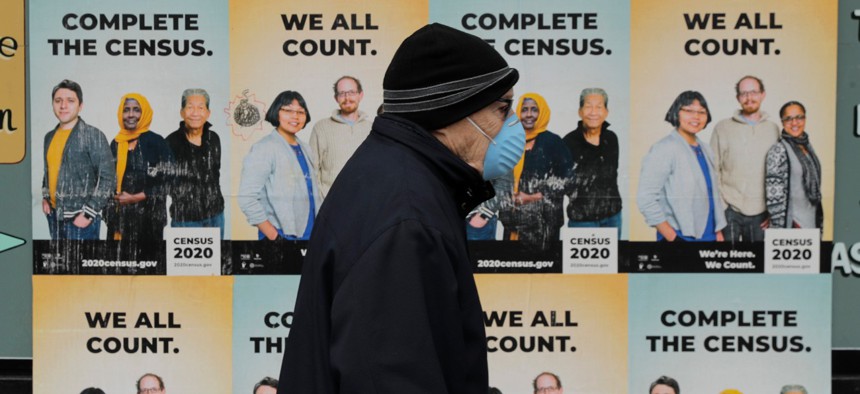
A man walks past posters encouraging participation in the 2020 census on April 1 in Seattle. Ted S. Warren / AP
Census Delays Create Uncertainty for Temporary Workers
Bureau faces a series of risks as it attempts decennial count during a pandemic.
The Census Bureau is quickly adjusting its staffing as it conducts its decennial count of all American residents amid a global pandemic that has created new challenges for an agency with little room for error.
Census paused hiring in March for the temporary workers it would need to complete its count and delayed most in-person operations due to the novel coronavirus outbreak. It has since restarted some of that work, completing “update leave”—a process by which bureau workers update address databases and hand-deliver paper questionnaires to housing units without standard addresses—in 75% of areas. The agency has restarted operations at all 248 of its stateside area offices.
The stops and starts have led to some uncertainty for Census’ temporary employees. As an incentive to stay with the agency while operations were frozen, Census paid those workers for about five weeks. Once some in-person activities resumed, the bureau began only paying those actually working. This brought about 18,000 employees off of Census rolls at the end of April.
The bureau is once again shrinking its paid workforce as update leave work wraps up and employees await subsequent phases. Census will soon begin in-person enumeration for a small number of hard-to-reach households in Maine and Alaska, before starting its widespread door-knocking in August for households across the country that did not self-respond. The bureau planned to hire 500,000 workers to complete the 2020 count, but has since said it will up that number as it anticipates more applicants will drop out of the process due to the pandemic.
In a report this week, the Government Accountability Office said Census is likely to encounter challenges during its efforts to hire more employees than it had planned for "within compressed timeframes.” The bureau had exceeded its selection goals in March when it paused hiring, GAO said, though it will now have to onboard and train those workers in an altered, socially distanced environment and under tighter deadlines. GAO added that it has surveyed Area Census Office managers and they have raised concerns related to worker safety and the effect of safety measures on staffing levels. The managers also said the Census Bureau has not ensured offices can continue operations remotely if coronavirus spikes force new closures.
Agency management said it has secured adequate equipment and supplies for its employees and would examine a “range of options,” including telework, to address continuity of operations concerns. GAO highlighted other risks the pandemic presents to the Census including communicating contingency operational plans, monitoring potential problems with IT systems, managing disinformation and evaluating the impact of the delay on data quality.
The current self-response rate for the Census is 60.8% nationwide, actually exceeding the bureau’s goal of 60.5% by June 10. That obscures the challenges the bureau faces, GAO noted, highlighting some counties in Alaska, Texas, Utah and South Dakota have self-response rates of less than 3%. Management attributed the significant differences to delays to its in-person operations, such as update leave.
Census has reached out to applicants with job offers to let them know about delays and new social distancing policies, but the agency will have to wait to see if hundreds of thousands show up as planned once full operations resume. For now, those would-be workers—and even many of those who have begun and since completed initial work—remain unpaid.
“Employees who have completed their work are waiting for the next phase,” the bureau said in a statement. “As we continue through revised operational phases, the numbers will fluctuate based on workload.”







